
The Regia Marina (RM) or Royal Italian Navy was the navy of the Kingdom of Italy from 1861 to 1946. In 1946, with the birth of the Italian Republic, the Regia Marina changed its name to Marina Militare.

Naval warfare in the Mediterranean during World War I took place between the naval forces of the Entente and the Central Powers in the Mediterranean Sea between 1914 and 1918.
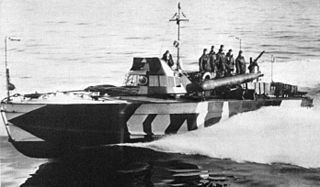
Motoscafo armato silurante, alternatively Motoscafo antisommergibili and commonly abbreviated as MAS, was a class of fast torpedo-armed vessels used by the Regia Marina during World War I and World War II. Originally, "MAS" referred to motobarca armata SVAN, Società Veneziana Automobili Navali.

The Adriatic Campaign of World War I was a naval campaign fought between the Central Powers and the Mediterranean squadrons of Great Britain, France, the Kingdom of Italy, Australia, and the United States.

The Second Battle of Durazzo, or the Bombardment of Durazzo was a naval battle fought in the Adriatic Sea during the First World War. A large allied fleet led by the Regia Marina attacked the enemy-held port at Durazzo, Albania. The fleet destroyed the Austro-Hungarian shore defenses and skirmished with a small naval force. Allied forces involved primarily were Italian though British, American and Australian warships also participated. It was the largest naval battle the United States participated in during the war. Most of the city was destroyed in the bombardment.
The Bakar mockery, or Bakar raid, was a raid of the Italian Navy in the last year of World War I. Whilst it had little material effect on the war at sea, it was a particularly bold venture which had a welcome effect on Italian morale, which was at a low ebb following the defeat at Caporetto a few months prior.

Cesare Rossarol was an Italian scout cruiser. Commissioned into service in the Italian Regia Marina in 1915, she served during World War I, participating in the Adriatic campaign until she was sunk in 1918.

T1 was a seagoing torpedo boat that was operated by the Royal Yugoslav Navy between 1921 and 1941. Originally 76 T, a 250t-class torpedo boat of the Austro-Hungarian Navy built in 1914, she was armed with two 66 mm (2.6 in) guns and four 450 mm (17.7 in) torpedo tubes, and could carry 10–12 naval mines. She saw active service during World War I, performing convoy, escort and minesweeping tasks, anti-submarine operations and shore bombardment missions. In 1917 the suffixes of all Austro-Hungarian torpedo boats were removed, and thereafter she was referred to as 76. She was part of the escort force for the Austro-Hungarian dreadnought Szent István during the action that resulted in the sinking of that ship by Italian torpedo boats in June 1918.

Quarto was a unique protected cruiser built by the Italian Regia Marina in the 1910s. Her keel was laid in November 1909, she was launched in August 1911, and was completed in March 1913. She was the first Italian cruiser to be equipped with steam turbines, which gave her a top speed of 28 knots. Her high speed was a requirement for the role in which she was designed to serve: a scout for the main Italian fleet.

Audace was a destroyer of the Italian Regia Marina. Originally, the Imperial Japanese Navy ordered her as the Urakaze-classKawakaze, but the Japanese sold her to the Kingdom of Italy in 1916 while she was under construction. Commissioned in 1917, she played an active role in the Adriatic campaign of World War I. During the interwar period, she operated in the Adriatic, Aegean, Mediterranean, and Red seas and was reclassified as a torpedo boat in 1929.
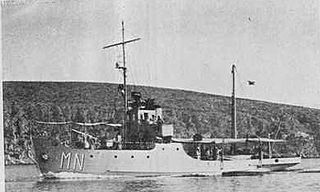
The Albona class were mine warfare ships used by the Italian Regia Marina and Royal Yugoslav Navy. Fourteen ships were originally laid down between 1917 and 1918 for the Austro-Hungarian Navy as the MT.130 class. However, the end of World War I and the dissolution of Austria-Hungary left them incomplete until 1920, when three ships were finished for the Regia Marina. These ships were armed with two 76 mm (3 in) guns. An additional five ships were completed for the KM in 1931 as the Malinska or Marjan class, and were armed with a single 66 mm (2.6 in). All of the completed ships could carry 24 to 39 naval mines. The remaining ships were never completed.

T7 was a sea-going torpedo boat operated by the Royal Yugoslav Navy between 1921 and 1941. Originally 96 F, a 250t-class torpedo boat of the Austro-Hungarian Navy built in 1915–1916, she was armed with two 66 mm (2.6 in) guns and four 450 mm (17.7 in) torpedo tubes, and could carry 10–12 naval mines. She saw active service during World War I, performing convoy escort, patrol, and minesweeping tasks, and anti-submarine operations. In 1917 the suffixes of all Austro-Hungarian torpedo boats were removed, and thereafter she was referred to as 96.

T5 was a sea-going torpedo boat operated by the Royal Yugoslav Navy between 1921 and 1941. Originally 87 F, a 250t-class torpedo boat of the Austro-Hungarian Navy built in 1914–1915, she was armed with two 66 mm (2.6 in) guns and four 450 mm (17.7 in) torpedo tubes, and could carry 10–12 naval mines. She saw active service during World War I, performing convoy, patrol, escort and minesweeping tasks, anti-submarine operations and shore bombardment missions. In 1917 the suffixes of all Austro-Hungarian torpedo boats were removed, and thereafter she was referred to as 87. She was part of the escort force for the Austro-Hungarian dreadnought Szent István during the action that resulted in the sinking of that ship by Italian torpedo boats in June 1918, and rescued many of her crew.

T8 was a sea-going torpedo boat that was operated by the Royal Yugoslav Navy between 1921 and 1941. Originally 97 F, a 250t-class torpedo boat of the Austro-Hungarian Navybuilt in 1915–1916, she was armed with two 66 mm (2.6 in) guns and four 450 mm (17.7 in) torpedo tubes, and could carry 10–12 naval mines. She saw active service during World War I, performing convoy escort, patrol, and minesweeping tasks, and anti-submarine operations. In 1917 the suffixes of all Austro-Hungarian torpedo boats were removed, and thereafter she was referred to as 97.

Giuseppe La Masa was the lead ship of the Italian La Masa-class destroyers. Commissioned into service in the Italian Regia Marina in 1917, she served in World War I, participating in the Adriatic campaign. She also deployed to protect Italian interests during the Corfu incident in 1923. Reclassified as a torpedo boat in 1929, she took part in the Mediterranean campaign of World War II until the Italian armistice with the Allies in 1943, when her crew scuttled her to prevent her use by the Germans.
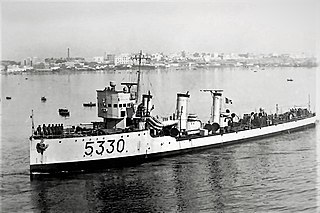
Giuseppe Cesare Abba was an Italian Rosolino Pilo-class destroyer. Commissioned into service in the Italian Regia Marina in 1915, she served in World War I, playing an active role in the Adriatic campaign. Reclassified as a torpedo boat in 1929, she participated in the Mediterranean and Adriatic campaigns of World War II. In 1943, she switched to the Allied side, operating as part of the Italian Co-belligerent Navy for the remainder of the war. She served in the postwar Italian Navy and was reclassified as a minesweeper in 1954. She was stricken in 1958.
Animoso was the second and final Audace-class destroyer of the Italian Regia Marina. Commissioned in 1914, she played an active role in the Adriatic campaign of World War I. Badly damaged by an accidental explosion in 1921, she was stricken in 1923.
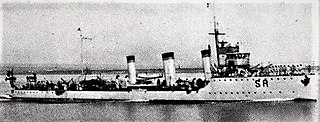
Giuseppe Sirtori was the lead ship of the Giuseppe Sirtori-class destroyers. Commissioned into service in the Italian Regia Marina in 1916, she served during World War I, participating in the Adriatic campaign. During the interwar period, she took part in operations related to the Corfu incident in 1923 and was reclassified as a torpedo boat in 1929. During World War II, she took part in the Mediterranean campaign and later the Adriatic campaign until she was scuttled in 1943.
Impavido was an Italian Indomito-class destroyer. Commissioned into service in the Italian Regia Marina in 1913, she served in World War I, playing an active role in the Adriatic campaign and seeing action in the Battle of the Strait of Otranto. Reclassified as a torpedo boat in 1929, she was stricken in 1937.
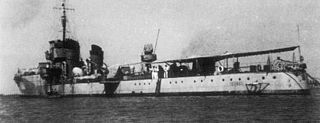
Guglielmo Pepe was an Italian Alessandro Poerio-class scout cruiser. Commissioned into service in the Italian Regia Marina in 1915, she served during World War I, participating in the Adriatic campaign, often supporting raids by Italian motor torpedo boats. She was reclassified as a destroyer in 1921 due to her light displacement. Like her sister ships, Alessandro Poerio and Cesare Rossarol, she was named after a famous Neapolitan light cavalryman who helped defend Venice from attacks by the Imperial Austrian Army during the revolutions in 1848.














